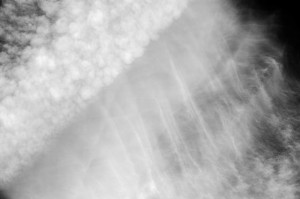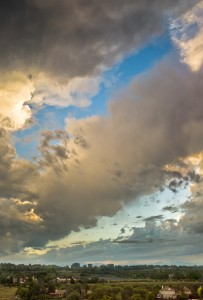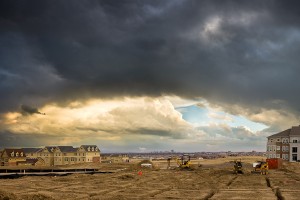In his essay Making Art New, Robert Adams considers the difficult and awkward topic of ‘newness’ in photography. Can there be anything new in photography when its genres have been covered so well by so many of its masters? Is this why, as Adams sadly notes, “a great deal of energy is being invested in attempts to push photographers into unusual areas”? And how should we react when photographers seemingly opt instead to re-plow old fields?
I pondered these questions as I attended the opening of Atmosphere, an exhibition of photographic work by Evan Anderman and Susan Blake currently on view (through May 26, 2012) at the Journey Through Landscape gallery in Denver. This is not a large exhibit, consisting as it does of only thirteen photographs. But the JTL is an intimate setting and the prints, each 20×30 inches and beautifully mounted on aluminum, fill the space nicely. The exhibit consists of seven of Blake’s color pigment prints and six of Anderman’s B&W carbon pigment prints.
The title, Atmosphere, is a hint that images of clouds are the common thread throughout the exhibit. However, each artist has a different take on the theme and—to my reckoning at least—their respective work relates to different genres. Anderman and Blake seemingly channel different past masters of photography. Thus, in the presence of the spirits of masters past, I could not help but muse about whether there was ‘newness’ here or not.
Cloud Study #56, Evan Anderman, 2012
Anderman’s photographs are of clouds and nothing else. Anderman’s clouds are fluffy or wispy; they are not the threatening variety. There is no sense of impending violence in the ‘atmosphere’ of these images, only a sense of daydreaming and of seeing rabbits in the sky. Such images stimulate contemplation, childhood memories and reflection. In Anderman’s Cloud Study #56, bubbling altocumulus clouds in the upper left triangle of the image give way to wind-stretched cirrus clouds that sweep down at an angle through the middle of the image only to give way themselves to horizontal cumulus clouds that fill the lower right triangle of the image. My mind’s eye saw not clouds but rather a lovely, ethereal ‘waterfall in the sky’. As beautiful as these photographs are to my eye, they are even more beautiful to my inner eye.
But Anderman’s Atmosphere also inevitably begs comparison to Equivalents, Alfred Stieglitz’ iconic series of cloud images, images meant to express Stieglitz’ innermost feelings. Is Anderman intentionally channeling Stieglitz and using images of clouds to express his (Anderman’s) innermost feelings? Or is he attempting something different?
Susan Blake’s cloud photographs are very different than Anderman’s. Of course Blake’s images are in color and Anderman’s in grayscale. But more to the point, Blake’s images are better described as ‘cloud-dominant’ rather than ‘cloud-only’ because, unlike Anderman’s photographs, Blake’s images include some landscape and some reference to man’s presence on Earth. Despite an attempt to mask ‘place’ by titling her images with made-up location names, the inclusion of landscape, however nominal, nonetheless give her images a place-stamp and a time-stamp. This too is in contrast to Anderman’s images which are placeless and therefore timeless. Further, Blake’s images are created using photo-merge techniques whereas Anderman’s photographs seemingly are ‘straight’. Blake added the clouds to a bit of landscape (or was it the other way around?). Regardless, Blake’s images are stunning. Captured in either early morning or late evening light, her clouds are exquisite in their tints and tones of magenta. Dominating over man’s comparatively feeble creations below, her clouds are magnificent in their mass.
Cherry Creek Lake, Susan Blake, 2012
In four of Blake’s images, man’s presence in the scene plays the role of the foil to the dominating clouds. In these images only the peak or chimney of a house intrudes in the lowermost portion of the scene. If more of man’s presence is included, as in her Cherry Lake Village, the overall sense is pastoral, the massive and dominating clouds offering shelter over a peaceful suburban village. If these four photographs were the entirety of Blake’s contribution to the exhibit then, despite the technical differences described earlier, her images would be emotionally more akin to those of Anderman’s than not. But the inclusion of three other Blake images, Sky Pointe Estates, Eagle Bluff Commons, and Ranchdale Crossing, throws this notion into doubt.
Eagle Bluff Commons, Susan Blake 2012
In these three images it was impossible not to sense the influence of Robert Adams and his New West landscapes. For in them Blake seems to be trying—as did Adams—to find beauty even as man irreparably disfigures the land. In Eagle Bluff Commons, for example, although massive clouds dominate the photograph’s image space, it is the lower third of the image—a human-scape—that dominates the photograph’s emotional space. In the far background, on the horizon, is a city (Denver?) with a vapor plume from some refinery or smokestack rising like a mini A-bomb mushroom next to buildings tall enough to scrape the bottom of the clouds. In the foreground is a classic Adams’ scene: a new housing complex in development and huge earth movers carving up the land in preparation for even more apartments. The duality present in these three images—beauty and irony—is inescapable. Was this duality present in the four other Blake photographs but just not as apparent? Is Blake’s Atmosphere merely a new New West?
In the end, however, it didn’t matter to me whether Atmosphere is ‘new’ or whether Anderman and Blake, in their own fashion, were refreshing the works of previous masters. I found their Atmosphere to be beautiful and thought provoking regardless. What more, then, could I ask of these two artists and their art?
As Adams concluded in Making Art New, “We welcome contemporary art, then, for its power to please the eye, to record the texture of current experience, and to invest that experience with meaning.” With regards to Atmosphere, I couldn’t agree more.


